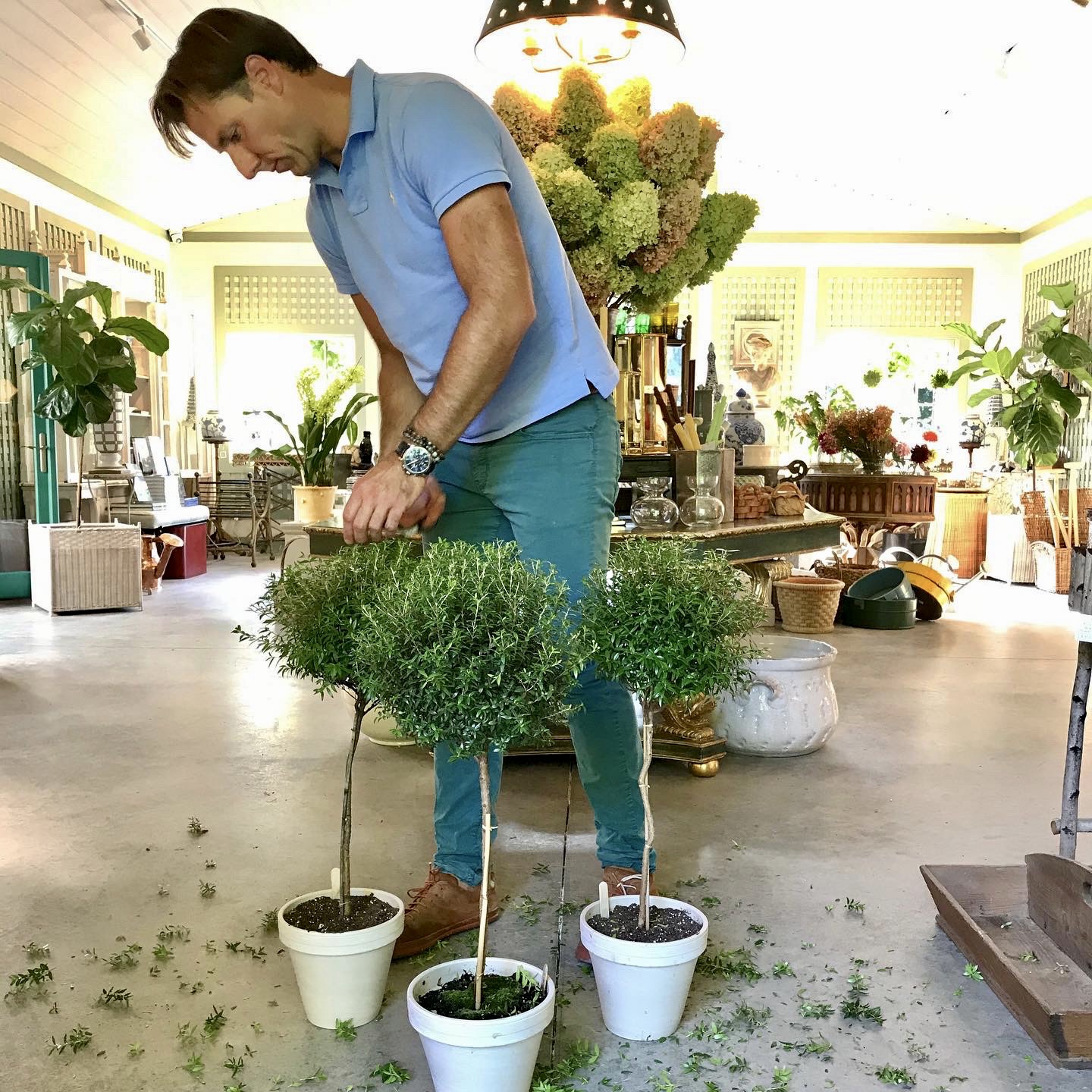To topiary or not to topiary? While letting plants flourish au naturel can yield breathtaking results, there’s no denying the charm of a carefully manicured piece of greenery. “Essentially, topiary the art of training, trimming, and guiding a plant into a shape that is different than its natural form,” explains our resident green thumb, landscape architect Anthony Bellomo of Millbrook’s Orangerie Garden + Home. “In other words, instead of just letting a plant grow as it would in nature, you’re manipulating it to create a more perfect or unique shape.”
The final result can vary widely depending on the type of plant. “Really, there’s no limitation on how big a topiary can get—you could have a six-inch-high rosemary plant clipped into a ball, or you could have an eight-foot big outdoor shrub trained into a shape,” says Bellomo. And while the former might be easily accessible at your local nursery, the latter requires a serious commitment. “Unlike some of the indoor houseplants that you can grow quickly, those big topiaries that you see in old French or English gardens can take years and years and years to have your desired effect. My long-term dream is to have four big evergreen shrubs anchor the corners of my garden!”
Curious about starting your own topiary garden? Read on for Bellomo’s essential tips and tricks.
1.If you’re a garden novice, start off with a pre-trained topiary.
“For the beginner, I would suggest buying a topiary from a garden shop, nursery or florist. It’s helpful to get some experience by just maintaining the existing form. As it grows, you can give it an occasional clip to either keep the shape that it was already in, or to guide it to get larger.”
2.Want to DIY? Depending on the type of plant, you’ll need a frame or a stake to help guide the shape.
“Some topiaries are trained on a frame. For example, ivy can then be wound around a metal frame to create a ball, a ring, or a sphere. But a metal frame isn’t always required: If you use myrtle or rosemary or a similar type of plant that has small dense leaves and allows for aggressive clipping, you would tie it to a stake for stability, and the constant clipping and training would create the shape.”
3.Think about your topiary’s future home.
“A topiary is going to have different requirements depending on its location. A simple boxwood shrub that’s planted outdoors and trained into a sphere will require fairly minimal care, because the plant is already established and hearty; it just needs occasional watering and clipping. For an indoor topiary, you have to pay very close attention to the environment the plant is in. For example, myrtle, rosemary and cypress are all plants that would typically live in very sunny Mediterranean climates, so you would want to mimic those same conditions as best as you can and make sure they get as much sun as possible. It’s also helpful to rotate the plant every so often, so that it gets light on all sides and grows evenly.”
4. Clean clippers and moisture checks are key.
“As it grows, you’re going to want to clip it to maintain it, and that can be done with something as simple as a sharp, clean pair of scissors, or a pair of narrow blade pruners, anything that’s going to give you a nice, crisp cut. And check the soil’s moisture level regularly: I usually recommend watering every two to three days, so the soil isn’t sopping wet, but it feels moist to the touch. You never want to let a potted topiary dry out completely, because it gets very hard to bring it back once it’s gone dry.”
5.Most topiaries thrive in warmth, humidity and sunlight—not unlike us!
“Humidity keeps topiaries healthy and happy. In the winter especially, when a lot of outdoor plants are brought inside to get out of the cold, you can mist the plant—even if it’s just once a week—to add moisture to the exterior of the leaves. Then, in the summertime when the weather is mild again and there are no more signs of frost, you can bring your plants outside and they’ll thrive in the humid air with warm temperatures and sunlight.”
6.Beware of toppling topiaries in windy weather.
“Tabletop-sized topiaries often get knocked over in a heavy windstorm because the plants are top-heavy—you have a small pot with a tall stem and a big foliage mass up at the top. If I know the weather is going to be windy, I will often take any topiaries off of tables outdoors and set them on the floor or put them in a protected space to ensure that they’re safe.”
7. Layer topiaries with cut flowers for a beautiful backdrop.
“What’s nice about topiary is that it gives you the opportunity to play with height, color and texture in the foliage. I like to use them on tables, on mantles inside the house, and on dining room tables, intermixed with cut flowers in little vases and votive candles and hurricanes. Topiary tends to usually be very formal in its appearance when it’s by itself, but when you add in ferns or flowers like begonias or geraniums, you can really get this interesting mixture that works together to create a composition.”
8.Use topiary to add a burst of greenery in any season.
“Topiaries can thrive all year round. They don’t typically shed their leaves, so they always look essentially the same, unlike plants that have a lifecycle during one season only. So they’re wonderful to have outside in the summer, and then you can take them inside when the weather gets colder, and they’ll continue to grow as long as they’re healthy. You just have to tidy and trim them—it allows you to stay active as a gardener all through the winter!”
9.From animals to architecture, get creative with shapes.
“In the very traditional or classic sense, topiaries are mostly balls, rings, cubes, or some other kind of geometric form. But, of course, there are people who have done all kinds of wonderful things with topiary, using shrub material to create animals and anything else they can imagine. I think it’s always so much more interesting when you mix together different shapes, even if it’s just having upright cones with balls. There is something very magical, joyful and fun about topiaries.”
10.When in doubt, you can’t go wrong with myrtle.
“My go-to for the quintessential, classical topiary is myrtle. We sell it in all different shapes and sizes. I love the rich green color of it, and it grows really beautifully and quickly. In fact, I give mine a trim very regularly, and it’s fun for me to watch them get larger and larger. When the new growth comes out, it’s very glossy and bright and shiny.”






















